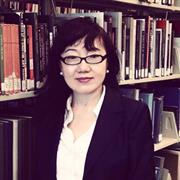Yi, Lidu Graduate Faculty
- Associate Professor, Art + Art History , College of Communication, Architecture and the Arts

Overview
biography
-
Dr. Lidu Yi is a historian of Chinese art and architecture specializing in medieval cross-cultural Buddhist art and archaeology along the Silk Roads. She earned her M.A. and Ph.D. at the University of Toronto in Canada. She is the author of Yungang: Art, History, Archaeology and Liturgy, the first comprehensive examination of a fifth-century court rock-cut cave-chapel complex, a UNESCO World Heritage site, and one of the greatest Buddhist monuments of all time, Yungang. It asks why, when and under what circumstances this impressive cave sanctuary was made and who played significant roles at various stages. Her initial questions were what was Yungang like in the fifth century, what were the important components of the entire complex, and what liturgical rituals were performed at this site, one of the most important Buddhist centers. These led to more questions and eventually became a book. Professor Yi’s current manuscript project primarily concentrates on Buddhist cave-chapel art, architecture and archaeology between the 5th and 11th centuries on the Silk Roads in northwest China. She is particularly interested in ritual practices in Buddhist sanctuaries, and inquires how and what liturgical practices were performed, based on literary sources and archaeological evidence, as well as the architectural space. This will shed important light on local beliefs and the usage and function of religious space such as temples and caves. She is also completing another book manuscript on the relatively unknown cave monasteries in Shan’xi Province.
Dr. Yi has long been interested in and worked on Ming-Qing literati paintings such as He Wore Flowers in his Hair by Chen Hongshou (1598-1652), and wrote about it: “Understanding a Late Ming Through his mid-Ming Subject.” She is working on another project: Aesthetics and Painting History through the Lens of Li Rihua 李日華 (1565-1635), a Ming scholar-connoisseur and a man of encyclopedic knowledge, whose name rivaled Dong Qichang during the Wanli (1573-1620) and Tianqi (1621-1627) eras. His Weishuixuan riji 味水軒日記 (Water Savoring Diary) records extensively his connoisseurship and interactions with different scholars, art dealers and collectors from 1609 to 1616, their visits to his house and his visits to antique shops and commodity markets; and his purchases of calligraphy, paintings, archaic bronzes, ceramics, gems, and ink stones. Li also writes in detail about his connoisseurship of Song and Yuan paintings and calligraphy and tells us about people bringing art pieces for his assessment and appreciation.
Dr. Yi has taught a wide range of courses: Buddhist Art and Archaeology along the Silk Roads; Introduction to East Asian Art; Arts of China and Japan; Modern and Contemporary Chinese Art; Later Chinese (960-1914); Masters and Masterpieces: Social History of Chinese Paintings; Literati Vision: Image and Text in Chinese Literati Paintings; Self and Other in Chinese Pictorial Art; Buddhist Art in Medieval China: The Iconology of the Dunhuang Caves; Art History Thesis
research interests
- Cross-cultural medieval Buddhist art, architecture and archaeology; Asian Studies; Literati paintings in Ming-Qing Dynasties; and contemporary art in China
Scholarly & Creative Works
selected scholarly works & creative activities
-
Article
-
2019
-
2014
-
2013
-
2011"HE WORE FLOWERS IN HIS HAIR'': UNDERSTANDING A LATE MING THROUGH HIS MID-MING SUBJECTFull Text via DOI: 10.1179/175975911X13204014980193 Web of Science: 000216156500003
-
Book
-
Book Chapter
-
2018
-
-
Conference
-
Other Scholarly Work
-
2021Book Review. 251-257.
-
Contact
full name
- Lidu Yi
Identifiers
ORCID iD
- https://orcid.org/0000-0002-8407-7122 (confirmed)